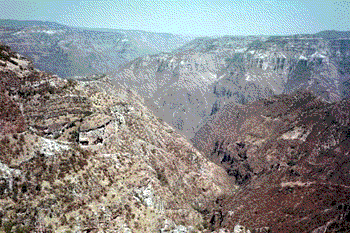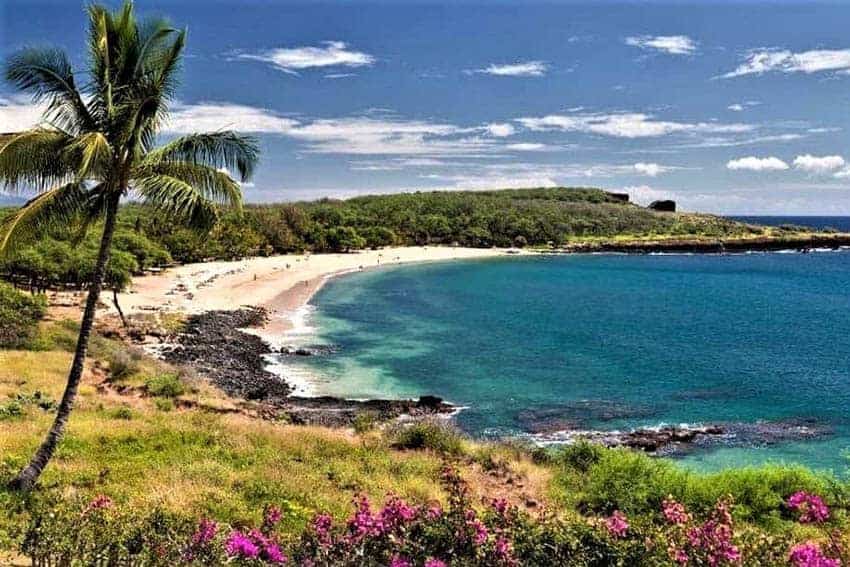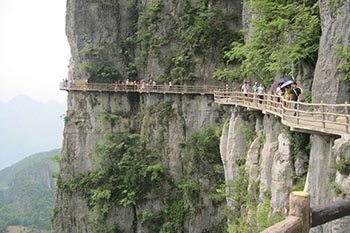
By Marie Javins
Quick, what is the largest, deepest canyon in North America?
If you answered “Grand Canyon,” you’d be wrong. No one can deny the drama of the Grand Canyon on a clear day. Without question, it is visually the most stunning canyon in North America and possibly the world.
Barranca Del Cobre
But its less-heralded southern cousin, the Barranca del Cobre or “Copper Canyon,” is deeper, longer, more remote, and certainly less visited. It is actually 20 canyons carved out of the Sierra Madre Occidental by at least six different rivers, and lacks the awe-inspiring central viewpoints of the Grand Canyon.
But the Copper Canyon features a manmade attraction as well; its scenic natural vistas are both marred and enhanced by the famous Copper Canyon Railway.
Chihuahua al Pacifico
The Copper Canyon Railway, or Chihuahua al Pacifico, features 36 bridges and 87 tunnels, and winds through harrowing switchbacks on sheer cliffs on its daily journey from sea level to 8,000 feet. It’s an impressive feat of engineering that rivals some of Switzerland’s Alpine routes and is one of North America’s most scenic railways. It’s also the only way to get to much of the Canyon and is the lifeline of the smaller towns.
Most tourists experience the Copper Canyon on an expensive all-inclusive first-class train tour, but budget travelers can experience the Copper Canyon Railroad too — for a fraction of the cost. Turbo the Bargain Hunter
Turbo the Bargain Hunter, an outdoorsy Australian famed for his ability to sniff out a sale in a 99-cent store (“Crikey, mate, these tacos are a fair dinkum bargain! Cheapest tucker I’ve had in ages!”), accompanied me to El Paso where we began our weeklong excursion into Mexico.
His Aussie Dollars
My US dollars were worth nine and a half pesos each, but Turbo’s Aussie dollars fetched only four and pocket change. We were going to have to cut a lot of corners. We acquired Mexican tourist cards, parked our car in a covered lot, and packed our stuffed kookaburra into a knapsack. After a few practice rounds of gracias and por favor, we were ready to cross the border.
Our Mexican holiday began with a Monday morning bus ride from El Paso on one of the four daily El Paso – Los Angeles Limousine Express buses. For a Turbo-sanctioned $25, we’d get whisked to Chihuahua in air-conditioned comfort. After clearing Customs, our bus bypassed the Ciudad Juarez bus station and stopped only once for squashed peanut butter and jelly sandwiches (us) and burritos (everyone else).
I had photocopied the sections we’d needed out of my brick-like Mexico guidebook before setting out, but — crikey — Turbo had tossed aside the Chihuahua section in a “lightening his luggage” frenzy before getting on the plane down under.
Hotel Nueva Reforma
We’d have to make do with scribbled notes taken in the El Paso Barnes and Noble travel section. The budget traveler’s bookstore-as-library trick served us well, and we toured rooms at two cheap hotels before settling on the slightly-less-seedy one — the friendly Hotel Nuevo Reforma on Calle Victoria. For $13 a night, we got a cheerfully decrepit room complete with squishy mattress, en suite bathroom, and cable television. Chihuahua-free Chihuahua
Chihuahua turned out to be a pleasant untouristed city, its central Plaza de Armas still featuring traditional architecture. We strolled through the nearby pedestrian mall and visited the 200-year-old baroque cathedral.
My plan to see the Pancho Villa museum was thwarted — it is closed on Monday. Turbo’s plan to see tiny, yapping dogs was also thwarted — we saw no chihuahuas in Chihuahua. But we did see plenty of Caballeros in trendy cowboy hats and pseudo-reptile-skin boots.
For a few pesos, the Cerro de la Cruz bus took us to the train station. Both first (Primera Express) and economy class (Clase Economica) tickets were available for tomorrow’s trains through the Copper Canyon, but the economy class tickets were half the price and the train left an hour later.
“Second class trains are subject to delays due to construction,” warned all the guidebooks I’d studied at Barnes and Noble. “You’ll reach the dramatic views of the Copper Canyon after dark, so take the first class train.”

“The construction is over,” declared the ticket agent proudly. “You will no longer be late. If there is a delay, it will be less than one hour.” We bought economy class tickets for the 7 a.m. departure and headed out to find dinner.
I had visions of colonial restaurants with atmospheric courtyards. “How about here?” asked Turbo, motioning to a taco stand yards from our hotel. I grimaced and sat down to explain mole sauce and taquitos to the Bargain Hunter. Fat Bellies, Full Wallets
The Bargain Hunter’s instincts were dead on, as a few dollars scored us some fantastic taquitos.
The couple that cooked our dinner was entertaining as well and dubbed Turbo Senor Kangaroosa. We returned to Casa Seedy with full bellies and fat wallets and headed to the train station again in the morning.
All our research had warned us about the state of the second-class train. It was to be a dusty,
people-oriented experience, in which we would have the opportunity to commune with the locals on a clattering, rickety train.
The guidebooks need to be updated. The second-class train was the recycled first-class train from just a few years ago, and it was as nice as any train I’d ever been on. Seats were comfortable and reclining, and all were next to clean, large windows.
We could put down the mini-blinds when the sun shone in, the air-conditioning was on full-blast, and seat assignments were made based upon destination. Everyone who was going to the end of the line got to sit on our quiet car, leaving those on local journeys to mill about in other cars. We were disturbed only by the occasional hot noodle or soda seller, and even the train toilets were immaculately clean.
Swaying Tan Ranchlands
The vast expanses of swaying tan ranchlands gave way first to the high desert, then to craggy cliffs, and finally pine forests as we ascended the mountains and approached Creel in the afternoon. Creel is near the highest point on the railway, and as the largest Copper Canyon town, is the regional center for the indigenous Tarahumara people.
Several shy Tarahumara girls, dressed in full, pleated skirts, boarded the train to sell woven baskets and handicrafts. They disembarked at the next stop, and so did we. Divisidero
Divisidero, the official canyon rest stop, is a tiny town on the rim of the Copper Canyon that seems to exist solely to service the needs of passengers on the four trains that stop there daily. Each train halts for 15 minutes, and Mexicans and foreigners alike all rush to the canyon rim, cameras at the ready.
Then, whirlwind tour complete, they snap up Tarahumara souvenirs and run up to the gordita sellers near the train. Everyone wolfs down their gorditas, as messy, hot food is not allowed back into the train cars. (Prepackaged snack foods are fine.)
The train whistle blew a warning. I shoved half my gordita at Turbo, who swallowed it whole, and we ran back to our red Chepe car. The first seven hours of train-riding had been enjoyable, but we could easily have taken the faster, cheaper bus from Chihuahua to Creel as the most dramatic scenery is located between Divisidero and Loreto.
We spent the next six hours glued to the window, or occasionally outside between the cars (a post that must be abandoned whenever the guard is near as it is a no-no).
Now we got the towering canyon walls, the sheer drops, and craggy cliffs we’d been hoping for. The onslaught of dramatic vistas slowed down after the tiny town of Temoris, and we were relieved (and hungry) when our 13-hour journey finally ended at the colonial town of El Fuerte. El Fuerte was once the capital of the state of Sinaloa and dated back to 1564. It was a major Spanish settlement for decades and still retains many picturesque colonial buildings.
It is a working town, not heavily touristed, but its tourist economy is growing rapidly as travelers are discovering its quaint cobblestone streets, friendly atmosphere, Spanish architecture, and gorgeous hotels. We did not have the funds to stay in one of these gorgeous hotels, however, and spent our first hour in El Fuerte touring the dives of central Juarez Street.
Several of the hotels around Juarez Street are affordable, but most of them did not meet our low standards. Hotel Guerrero stood out from the pack, with its clean rooms and friendly staff.
For $15 a double, we got a tiny, hot room around a plant-filled courtyard. Food stalls were located right across the street, and the hotel staff was constantly forcing complimentary bottled water upon us. Dinner was served at a taqueria around the main square, in the shadow of the Spanish colonial Palacio Municipal and the peach-colored Hotel Posada del Hidalgo.
A stage was set up near the cathedral, and high school students were singing karaoke as part of a week-long festival. I sat in the gazebo in the square, along with Turbo and a taco, and took in the perfect weather in the quaint Mexican mountain village. “Mate, this is fair dinkum amazing,” said Turbo quietly. Crikey — I had to agree.
The next day was spent seeing the town and its surroundings. People were friendly, the food was good, and the Spanish architecture charming. But strangely, there seemed to be heavily-armed policemen everywhere. El Fuerte, along with much of the region, had a frontier-like feel to it. I was sitting in the Hotel Guerrero courtyard when Turbo came running in from a bar down the street.
“I managed to order una cerveza,” he said proudly, “when — stone the crows — two blokes came in and surrendered their weapons at the bar!!” It was standard practice for Caballeros to hand over their knives and guns when they entered their local watering holes.
No wonder the police were so heavily armed. They had to have enough guns to take on anyone else’s supply of weapons. A few days later, we reluctantly left El Fuerte on the eastbound second-class train. This time we’d see the scenery in the morning light. Unfortunately, a haze had settled in and the views were disappointing. At Creel, we disembarked and left the train forever. We’d stay for a few days and then catch a bus back to the border.
Dry Creel
Creel is unique among the Copper Canyon towns, in that it has a well-developed tourist infrastructure. It has become the de facto tourist center along the railroad, due to its central location and comprehensive transit links.
Tourists use it as a jumping-off point for trips into the surrounding canyons and Tarahumara villages. Most travelers catch the bus from Creel to the village of Batopilas. The harrowing canyon-hugging ride itself is thrilling, but the real attraction is the hiking and canyon treks that can be arranged from Batopilas. We were on a tight schedule, so we’d have to settle for a day trip out of Creel.

Competition amongst Creel hotels had given us bargaining power. For once, we ignored the cheapest option in town — the frenetic Casa Margarita hostel — and checked into Cabanas Bertis, one of many cheap decent hotels.
Rates can be negotiated as low at $30 for two if you bargain hard. We were in Creel during the low season and did not have a wide variety of excursions to choose from.
Only Casa Margarita was full, but their tours are open to all, so we paid ten dollars each and went on a Casa Margarita hike to the Recohuata Hot Springs at the bottom of a 2000-foot deep canyon.
The real fun in Creel, however, was not in hiking the canyons but was in watching the Tarahumara people go about their business. The women we’d seen before, at Divisidero and on the train itself. The men were small but all-muscle, and they walked almost timidly through town in their colorful loincloths.
These were the same men who were famous for running 100-mile footraces (rarjiparo) through canyons, and shops sold the hard wooden balls that the men kicked as they ran. We left Creel on the morning bus six days after we’d arrived in Mexico. The direct bus to Ciudad Juarez never materialized that day, so the ticket seller urged us all to run over to the competitor’s bus.
A Noreste bus carried us along a paved road to Chihuahua. We ran parallel to the railway the whole time, and even passed the westbound train in the afternoon. At Chihuahua, the Bargain Hunter and I connected almost instantly to a posh, luxury bus bound for Juarez. In Juarez, the transfer to the El Paso-bound bus was simple. Exhausted, we arrived back at our car just after dark.
“Struth, what an amazing trip!” said Turbo. “I can’t believe we were only gone a week, mate.” And I couldn’t believe how well we’d eaten on so little money. I could get used to traveling on an Australian budget. More Information
Immigration requirements for Mexico:
Americans are allowed to visit Mexico’s border towns for up to 72 hours without visas. For longer visits, Americans need to acquire a tourist card. The immigration office is in Ciudad Juarez at the foot of the Stanton Street bridge. If catching a bus to Chihuahua or Juarez, you are advised to walk over early and apply for your tourist card as the bus may not wait. Rules seem to change frequently;
Parking in El Paso:
Lots line Santa Fe Avenue near the Santa Fe Avenue Bridge. There is a covered, semi-secure lot across from the Greyhound terminal, but there is no attendant off-hours. Pay in advance by check or go during business hours and get a receipt, as cash payment may be too tempting to attendants. .
Bus from El Paso to Chihuahua (5-hour ride):
El Paso – Los Angeles Limousine Expess, Inc. (first-class buses with heat, a/c, bathroom, TV’s, reclining seats) 720 S. Oregon at 6th Street, (915)532-4061 in Chihuahua: call (614)424-44-40 (dial 011-52 first from US) Runs 4 times daily. Buy tickets at the bus office the day before.
Competing bus companies that go to Chihuahua can be found along Santa Fe Avenue in El Paso. Try Los Paisanos or Americanos USA. Note that these buses go to their own stations both in El Paso and Chihuahua, not to the central bus stations. You will need to take a taxi on arrival.
Chepe “Chihuahua-Pacifico Railroad” Buy “Economy Class” tickets between 9-6 the day before at the train station. First Class tickets should be reserved ahead of time if possible, using a travel agent.
The train station is a 20-minute walk from the Chihuahua center, or catch the “Cerro de la Cruz” bus from near Tourist Information. Disembark at “20 de Noviembre” by the prison and walk one block (3 pesos).
During winter months, the Chihuahua to Los Mochis westbound “Economy Class” train will hit the best scenery after dark. Start from the western end or take the “First Class” train. During holidays, leave yourself a few days to make sure you get the ticket you want. Tickets are plentiful during other times.s.
Bus from Creel to Juarez:
Estrella Blanca bus departs Creel daily at 8:30 a.m. $40 one-way. Estrella Blanca and Noreste also have several daily departures for Chihuahua, where frequent buses leave for Juarez.Bus from Juarez to El Paso:
Americanos USA, L.L.C. 1007 S. Santa Fe and 825 S. El Paso (915)532-1748 and (915)545-2891, $5.00
Other buses travel the same route for the same price. The Juarez bus station is not central, and walking from the bus station to the border is not recommended.
Tourist info:
Mexico
El Paso/Juarez
Copper Canyon
Mexico and up-to-date info
Tourist info on El Fuerte:
Bus from the center of El Fuerte to train station leaves from El Fuerte center (Juarez Street) in front of food stalls across street from Hotel Guerrero at 7:45 a.m Cost is six and a half pesos, sign on front reads Estacion. Taxi at night from station is 50 pesos each — there is no bus.
Hotel Guerrero, 210 Juarez — best budget hotel with a nice courtyard and several styles of rooms at different prices. Cheapest room for two is 150 pesos for a tiny windowless double with en suite bathroom and fan.
Rate includes complimentary bottled water. Staff helpful.
Hotel San Jose, 108 Juarez — the cheapest hotel in town. Only for those on tightest budgets.
El Fuerte also futures many beautiful old beds and breakfasts for those with more money, Tourist info on Creel: Casa Margarita employs children who will find you at the train station and lead you to Margarita’s. It’s a chaotic hostel with meals included in dorm/room prices.
Crowded with budget travelers from around the world, it’s a great place for those who like a lot of company, although I found the use of children as bait unsettling. Also features some of the best-priced tours in town, but you don’t have to stay at the hostel to book a trip. Just walk in and sign up on the bulletin board the night before.
Cabanas Berti’s features clean, rustic rooms for 2 with fireplaces for 150-200 pesos a night. Negotiations will get you a lower rate. There are several hotels with similarly nice places in the same price range.
Note that Creel has chronic water supply problems. It is also at 7700 feet and is chilly even in summer.
How to start this trip from Los Mochis:
To start this trip on the western terminus of the Copper Canyon Railway, you’ll need to get to Los Mochis. Take a ferry from La Paz (Baja California) to Topolobampo (15 miles south of Los Mochis, catch a bus from there), or catch a bus from Nogales on the Arizona border. It will take you all the way to Los Mochis (12 hours). You can then return to the US from Chihuahua or Creel.
A useful guide to Mexico is Si-Mexico, with links to hotels and city guides
Marie Javins is a comic book colorist and author who lives in Los Angeles.
- Camino Tales: Wine and Memories in Galicia, Spain - July 25, 2024
- Beluga Hunting in Norway - July 20, 2024
- Costa Rica: A Rainforest Chocolate Tour - July 18, 2024






